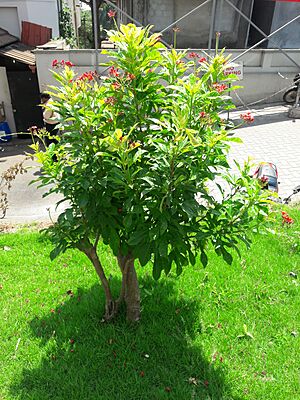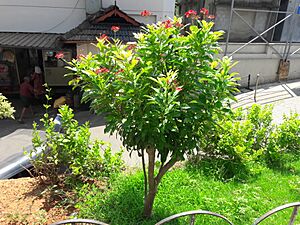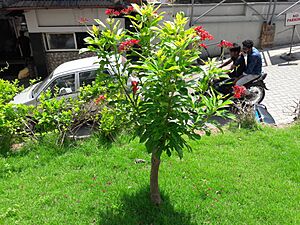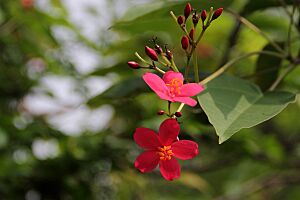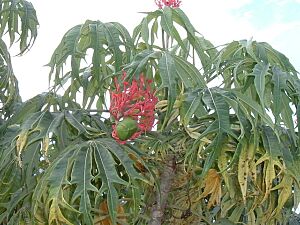Jatropha facts for kids
Quick facts for kids Jatropha |
|
|---|---|
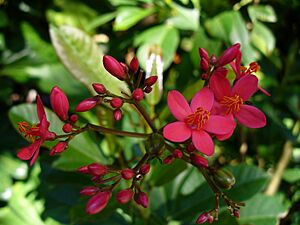 |
|
| Spicy Jatropha (Jatropha integerrima) | |
| Scientific classification |
|
| Kingdom: | Plantae |
| Clade: | Tracheophytes |
| Clade: | Angiosperms |
| Clade: | Eudicots |
| Clade: | Rosids |
| Order: | Malpighiales |
| Family: | Euphorbiaceae |
| Subfamily: | Crotonoideae |
| Tribe: | Jatropheae |
| Genus: | Jatropha L. |
| Species | |
|
Approximately 170, see Section Species. |
|
Jatropha is a group of about 170 different types of flowering plants. They belong to the spurge family, called Euphorbiaceae. The name Jatropha comes from two Greek words: iatros, meaning "physician" (doctor), and trophe, meaning "nutrition" (food). This is why it's sometimes called the physic nut. Another common name is nettlespurge.
Most Jatropha plants are succulent plants (which store water), shrubs, or trees. Some trees, like Jatropha curcas, lose their leaves every year (they are deciduous). Most Jatropha plants grow naturally in the Americas, but 66 types are found in the Old World (Europe, Asia, Africa). These plants have separate male and female flowers on the same plant.
Like many plants in the Euphorbiaceae family, Jatropha plants contain substances that can be harmful if eaten or touched. People have traditionally used Jatropha species for making baskets, tanning leather, and creating dyes. In the 2000s, one type, Jatropha curcas, became popular for making biodiesel fuel. It was also used as lamp oil and for some traditional medicines. People in Veracruz, Mexico, even grew a special Jatropha curcas that was not harmful. This made it a better source for biodiesel because its leftover parts could be used as food. But be careful: if safe Jatropha plants are pollinated by harmful types, they might become harmful again.
Contents
What Jatropha is Used For
The stems of the haat plant (Jatropha cuneata) are used by the Seri people in Mexico to make baskets. They prepare the stems carefully by roasting, splitting, and soaking them. The reddish color often used for these baskets comes from the root of another plant called Krameria grayi.
Spicy jatropha (J. integerrima) is a popular plant grown in warm places because its bright red flowers bloom all the time. The Buddha belly plant (J. podagrica) was used in Mexico and the southwestern United States to tan leather and make a red dye. It is also grown as a house plant.
Jatropha Oil and Biofuel
The oil from Jatropha curcas is mainly turned into biodiesel. This fuel can be used in diesel engines. It can also store heat or transfer heat at high temperatures. After the oil is taken out, the leftover part, called "cake," is rich in protein. If it's made safe, it can be used to feed fish or other animals. This cake can also be used to power electricity plants, make biogas, or serve as a good organic fertilizer.
In 2007, a big financial company, Goldman Sachs, said that Jatropha curcas was one of the best plants for making biodiesel in the future. This plant can handle drought (very dry weather) and is strong against pests. Its seeds contain a lot of oil, usually between 27% and 40%. The leftover seed material after oil extraction can also be used to create energy.
However, even though Jatropha plants are common and used for oil, they haven't been fully grown and improved by humans (not properly domesticated). This means that how much they produce can change a lot. We also don't fully know how growing them on a very large scale might affect the soil quality and the environment in the long run. Research in 2009 showed that making Jatropha biodiesel needs much more water than other common biofuel crops. Also, early ideas about how much oil it could produce were too high.
Jatropha curcas is also being studied for its ability to absorb carbon dioxide from the air in dry areas. This helps fight climate change.
Why Jatropha Can Be Harmful
Like other plants in the Euphorbiaceae family, Jatropha plants have several harmful substances. The seeds of Jatropha curcas contain toxic proteins and other harmful compounds. Even though they are harmful, the seeds are sometimes eaten after being roasted, which makes them a little less toxic.
The sap (liquid inside the plant) can irritate your skin. Eating just a few untreated seeds can be very dangerous for people. In 2005, Western Australia even banned Jatropha gossypiifolia because it spreads easily and is very harmful to both people and animals. While some people still use Jatropha for traditional medicine in certain places, one study found that its dried leaves did not stop fungi from growing.
Selected species
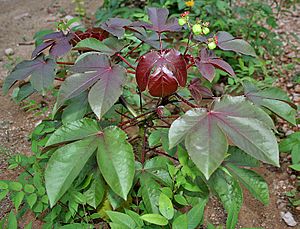

- Jatropha acanthophylla Loefgr.
- Jatropha augusti Pax & K.Hoffm.
- Jatropha breviloba (Morong) Pax & K.Hoffm.
- Jatropha bullockii E.J.Lott
- Jatropha cardiophylla (Torr.) Müll.Arg. – Sangre de Cristo
- Jatropha cathartica Terán & Berland. – Berlandier's nettlespurge
- Jatropha chamelensis Pérez-Jiménez
- Jatropha costaricensis G.L.Webster & Poveda
- Jatropha cinerea (Ortega) Müll.Arg. – Arizona nettlespurge
- Jatropha cuneata Wiggins & Rollins – Limberbush, haat (pronounced)
- Jatropha curcas L. – Physic nut, piñoncillo, habb-el-melúk
- Jatropha decumbens Pax & K.Hoffm.
- Jatropha dhofarica Radcl.-Sm.
- Jatropha dioica Sessé – Leatherstem
- Jatropha elliptica (Pohl) Oken
- Jatropha erythropoda Pax & K.Hoffm.
- Jatropha excisa Griseb.
- Jatropha flavovirens Pax & K.Hoffm.
- Jatropha glaucovirens Pax & K.Hoffm.
- Jatropha gossypiifolia L. – Bellyache bush
- Jatropha grossidentata Pax & K.Hoffm.
- Jatropha hernandiifolia Vent. – Wild oilnut
- Jatropha integerrima Jacq. syn. J. pandurifolia – Spicy jatropha, called in Chinese "ri ri ying", which means "every-day-flowered cherry blossom"
- Jatropha kamerunica Pax & K.Hoffm.
- Jatropha macrantha Mull. Arg – Huanarpo macho
- Jatropha macrophylla Pax & K.Hoffm.
- Jatropha macrorhiza Benth. – Ragged nettlespurge
- Jatropha multifida L. – Coralbush
- Jatropha nudicaulis Benth.
- Jatropha rivae Pax
- Jatropha podagrica Hook. – Buddha belly plant, bottleplant shrub
- Jatropha unicostata Balf.f.
- Jatropha velutina Pax & K.Hoffm.
- Jatropha weberbaueri Pax & K.Hoffm.
Gallery
-
Jatropha integerrima in West Bengal, India.
See also
 In Spanish: Jatropha para niños
In Spanish: Jatropha para niños


